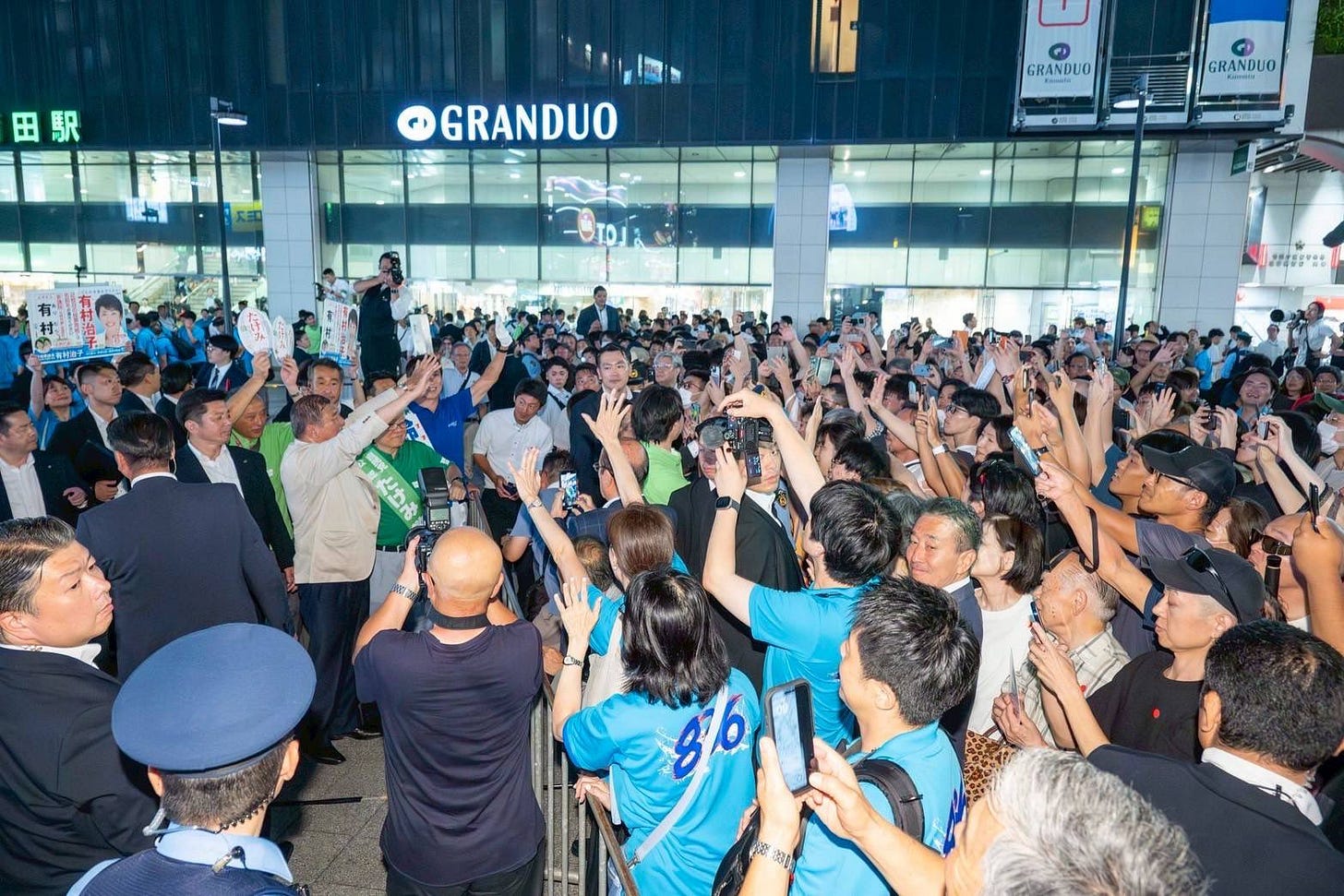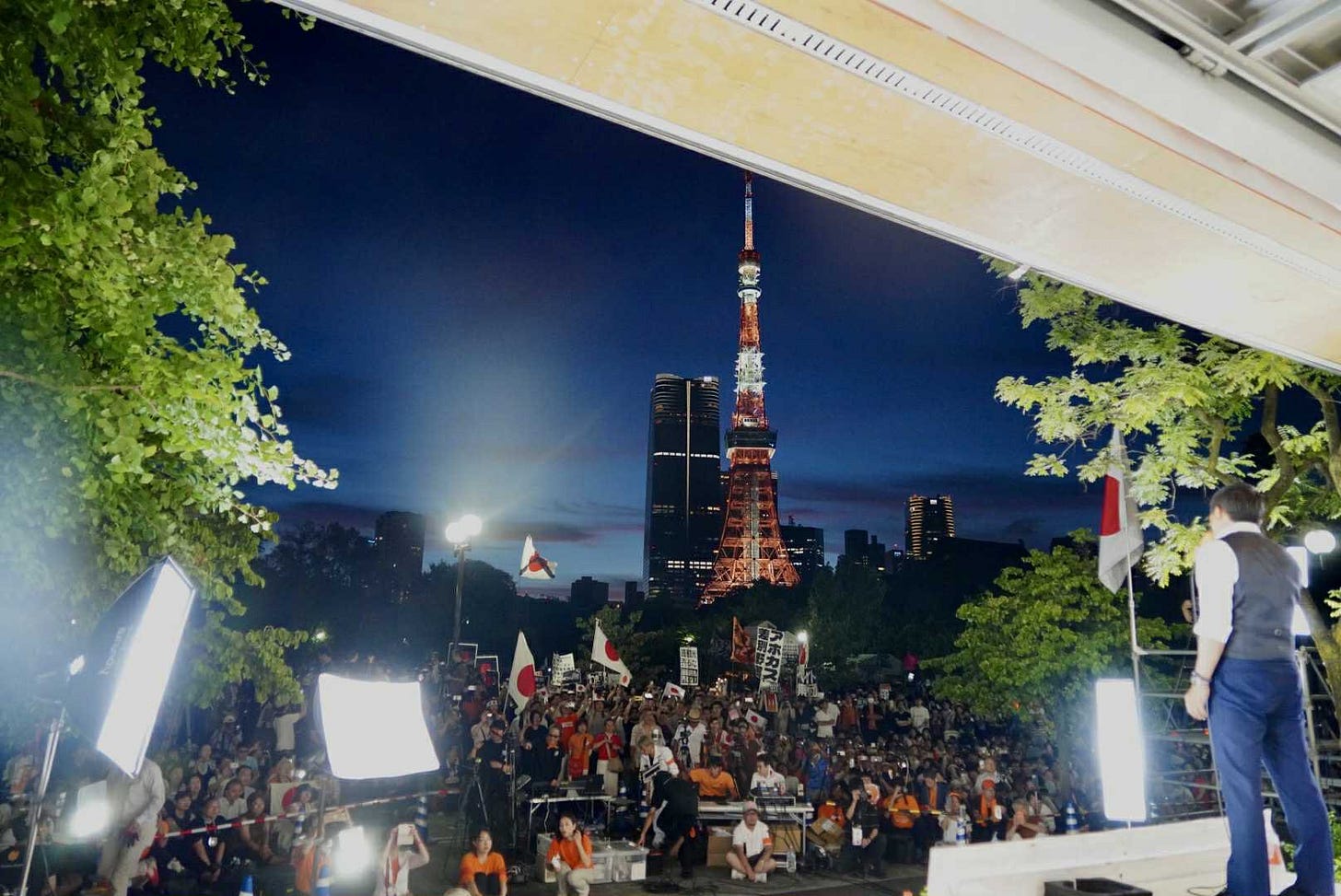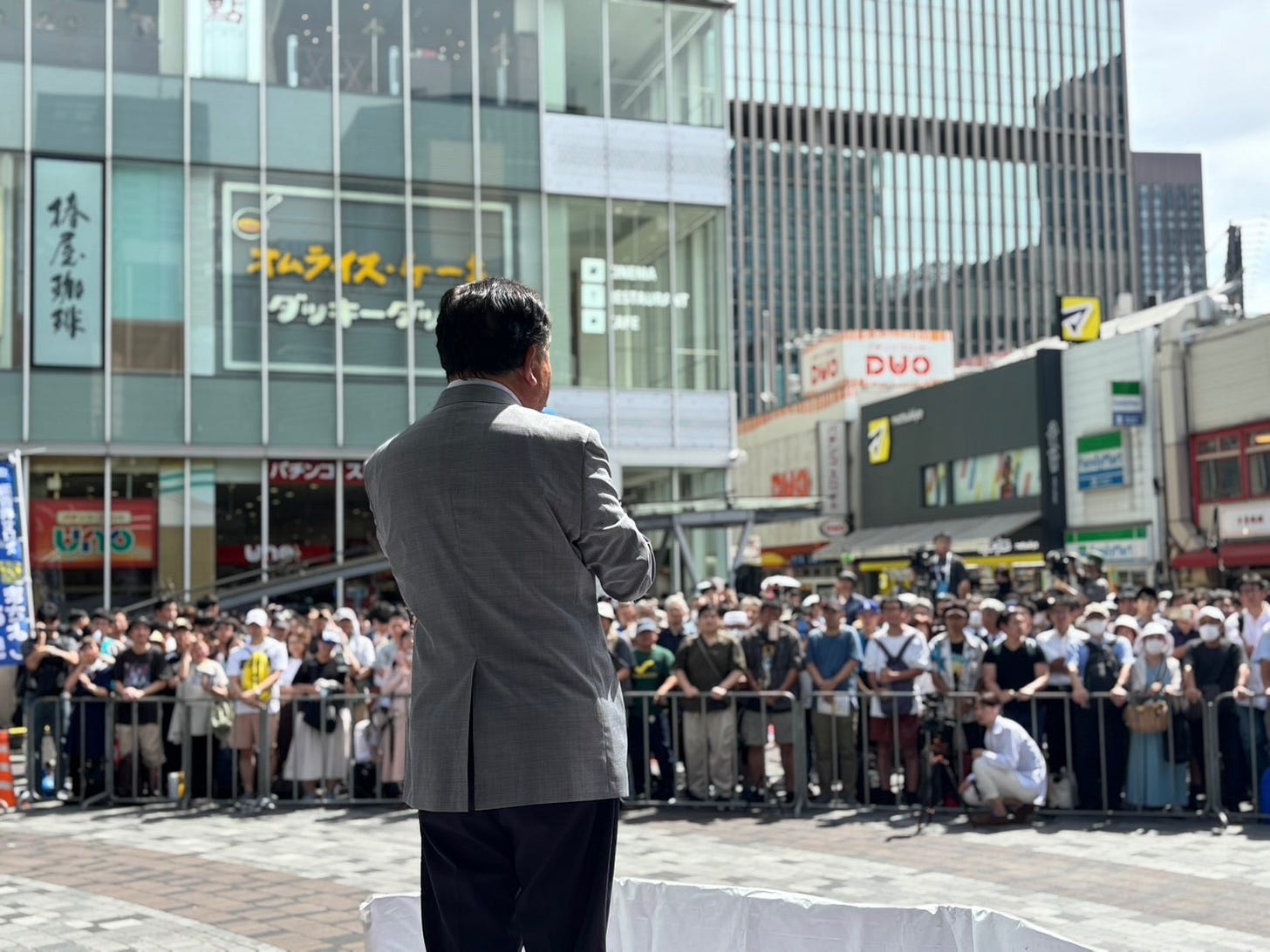Thirteen questions for the upper house elections and beyond
What I will be watching when Japan votes Sunday
Thank you for reading Observing Japan. This post is available to all readers.
A pdf of my viewer’s guide to the upper house elections — available to paid subscribers here — can be purchased here.
If you are looking for timely, forward-looking analysis of the stories in Japans’s politics and policymaking that move markets, I have launched a new service through my business, Japan Foresight LLC. For more information about Japan Foresight’s services or for information on how to sign up for a trial or schedule a briefing, please visit our website or reach out to me.
Paid subscribers will be able to join a Substack chat following the results in real time here. I will also be posting updates on Bluesky.

The upper house campaign is over, the candidates have had their last rallies, and the fate of the Ishiba government is now in the hands of the voters.
Ahead of election day, here are the thirteen most pressing questions that I am watching as the Japanese people go to the polls.
What will the electorate look like?
It has been more than thirty years since turnout in an upper house election was at least 60%. The last time this year’s incumbents faced voters, in 2019, turnout fell below 50%, reaching only 48.8%. The Liberal Democratic Party’s (LDP) post-2012 dominance depended heavily on low turnout in both lower and upper house elections, as voters, particularly independents, who were dissatisfied with LDP rule were often frustrated with the opposition too.
Will this year be different? There may be some indications that more voters, particularly younger voters, will turn out to vote. Early voting is an imperfect indicator since there is no way of knowing if early voting reflects enthusiasm, the growing embrace of early voting, or, this year, the impact of holding an election on a third-day weekend. But 21.45 million people, more than 20% of the electorate, voted early this year, significantly more than 2022, with particular large early turnouts in Tokyo, Kanagawa, and Aichi. A larger, younger, more urban electorate will be a bad sign for the ruling coalition.
What impact will negative stories about Sanseitō have?

Sanseitō is clearly the single most-important story of this election, in the impact it could have on the outcome, its virtually single-handedly putting the issue of Japan’s foreign population on the agenda, and its arrival as a “fourth pole” of the party system only three years after its founding. However, its meteoric rise has meant that both other political parties and the media have been playing catch-up when it comes to scrutinizing the party’s conduct, its funding, and the proverbial dirty laundry of its leaders and candidates.
For example, I did a quick search of the Nikkei Shimbun online for articles about the party. Since it was first mentioned in an article on 24 June 2022, the newspaper has written 370 articles that mention Sanseitō at least once. Of those articles, 148 have been published since 1 June 2025. Another 46 were published between 1 January and 31 May 2025. In short, just over half of the mentions of the party in one of Japan’s leading newspapers come in articles published since the start of this year; 40% have been published since the start of June.
Perhaps it should not be surprising then that the final week of the campaign has seen the government warn that foreign powers have intervened in the election, just after a leading Sanseitō candidate appeared on Russian state television, prompting LDP and other candidates to question the party’s ties with Russia; major weekly tabloids publish scoops about questionable findings in the party’s finances; and local governments and rival parties call out the party for defamatory comments. But most of these stories, particularly the question of Russian interference, surfaced after the last round of opinion polls. It is therefore unclear whether these accusations will blunt the party’s performance. Will late-deciding voters who might have supported Sanseitō switch to the Democratic Party for the People (DPFP), opt for the LDP, or just stay home?
Will the DPFP’s ceiling be limited by Sanseitō?

While Sanseitō is threatening to peel off LDP voters, it is also a threat to the DPFP, which has slipped in approval ratings at the same time that Sanseitō has climbed, with the latter passing the former in most polls. The two parties are competing for many of the same voters – younger, urban floating voters who feel frustrated with the LDP’s stewardship of the economy – and there is a real risk that the DPFP could under-perform relative to expectations if Sanseitō cuts into the DPFP’s support in multi-member constituencies and PR voting. Both parties are likely to grow, but the election will reveal much about their relative clout.
Does Kōmeitō’s electoral machine still work?
The long-term decline in Kōmeitō’s ability to mobilize voters has quietly been one of the most important developments in Japanese politics over the past five years, and is clearly a factor in the LDP’s weakening grip on the political system.
With polls showing that the party is at risk of losing seats in multi-member districts that have been its “reserved” seats for years, after this election the party's decline will be undeniable and could have material consequences if it triggers both the LDP and Kōmeitō to question the value of their coalition after a quarter century together. Of course, the more immediate question is whether Kōmeitō’s ability to defend its incumbents is the difference between victory and defeat for the ruling coalition.
Can the CDP break out?
Even though this upper house election has become an election in the very survival of the incumbent government is at stake, the leading opposition party has been an afterthought during the campaign. In many ways the Constitutional Democratic Party (CDP) resembles its leader, Noda Yoshihiko: solid and competent but unspectacular. The party has campaigned effectively in single-member constituencies and has even managed to cooperate with other opposition parties in limited cases. But it's unlikely to increase its PR vote significantly. A stronger CDP would solve a lot of problems in the political system; it's worth watching to see whether the party can improve at all this year.
How low will Ishin no Kai go?
Although Ishin has a candidate in Tokyo, its leaders’ itineraries tell the whole story: the party is fighting for its Kansai stronghold, working to defend its two seats in Osaka, as well as seats in Kyoto and Hyogo.
Is there any way for Ishiba and the LDP to pull off a victory?
The vibes around Ishiba's campaign have been terrible, with the prime minister cancelling a campaign stop days before the vote, a prefectural party chair snubbing him, and his leading rival declaring her desire to run for the leadership again two days before the election. When combined with polls pointing to the possibility of the LDP’s performing as bad as it ever has in an upper house election, the mood in LDP headquarters must surely be gloomy. To be sure, there's always the possibility of a major polling miss, though the fact that every pollster is pointing the same direction suggests that this is unlikely and, if there is a polling miss, it may be more likely to be unfavorable for the LDP, considering that younger voters are harder to poll and more likely to support the anti-establishment parties.
At this point, it seems that for the LDP to outperform expectations – or protect the ruling coalition's majority – will depend on every other question presented here. If voters get cold feet about Sanseitō; if Kōmeitō is able to defy trends; if higher turnout does not materialize; if tepid enthusiasm for the CDP means the party falls short in close single-member races. It's difficult to see the LDP winning without some combination of these factors. It may also depend on whether the LDP was able to scare enough voters about the chaos that awaits if the ruling coalition cannot hold the majority, which Asō Tarō helpfully distilled here:
If the ruling coalition loses, will Ishiba quit, and if so, when and how?
This may be the most important question of all. It is difficult to see how Ishiba survives if the ruling coalition’s majority doesn't, but it may depend on how poorly the coalition performs. If the coalition is just short of the 50 seats it needs – which at this point would feel like a moral victory – there's a world in which Ishiba could try to hold on, though he will surely face calls from within the LDP to resign if the party is below the victory line. But if the defeat is closer to the worse outcomes projected from polling, his exit seems like a foregone conclusion, with the only question being whether he quits Sunday night or whether he waits a day or two to resign.
Who will lead the LDP?
If Ishiba quits, the party will undoubtedly move quickly to replace him. Consider that in 2020, when Abe Shinzō resigned, the party formally began its leadership campaign ten days later and selected Suga Yoshihide as his successor six days after that. In other words, it will be very different from the 2024 election that Ishiba won. It will be short; it will be dominated by party bosses; and it will occur against the backdrop of the looming deadline for US tariffs to kick in. While it is tempting to assume that Takaichi Sanae is the presumptive favorite, the party electors will have to weigh a few competing factors, including not only who can unify a fractured party, but also who can bring back voters who have defected over the past two elections; who can excite the public more broadly and reverse the impression that the LDP is out of touch; who can negotiate with the opposition parties, and, ideally bring at least one into the government; who can manage negotiations with the United States, which seem likely to continue beyond 1 August; and who can prevail in the next general election, whenever it comes. The party will have to reckon with this choice in a process that will not be structured by factions and in which rank-and-file members will not necessarily have the opportunity to express their preferences, since prefectural chapters may not necessarily hold open votes to determine how to distribute their three votes.
Can the LDP convince one or more parties to join the ruling coalition and enable the government to control the legislative process?
Whatever happens on Sunday, the LDP-Kōmeitō ruling coalition will face the same problem it faced before the election. Without a majority in the House of Representatives, the government has to negotiate to pass anything, budgets included; if the coalition loses its majority in the upper house, it will lose an important source of leverage in negotiations with the opposition, since in theory if enough opposition lawmakers can agree that could move legislation through both houses without the government being able to stop it (in contrast to what happened when the opposition parties got together to pass legislation scrapping the temporary gasoline tax through the lower house that died in the upper house).
Losing control of the upper house will make it even more urgent to find a way to reassert control over the legislative process. While one option would be to gamble on a snap election and try to win a new legislative majority, a snap election would be enormously risky. The other option is to try to convince one of the opposition parties with enough votes to close the gap in the lower house – the CDP, the DPFP, or Ishin no Kai – to join a coalition government, hence the ability to convince an opposition party to join the coalition will be an important qualification for whoever leads the party. It is unlikely that any party will join a coalition with Ishiba as leader, seeing as no party seems inclined to give Ishiba a lifeline when he is floundering. But it is conceivable that a new party leader might have more success bringing either the DPFP or Ishin no Kai into the government, particularly if they feel that they need to deliver some policy achievements to their supporters to head off the Sanseitō threat. Of course, if the LDP can do that, it will neutralize the threat of a no-confidence motion – the CDP cannot pass one on its own – though at the price of having to manage a larger, more unwieldy coalition with a new partner who could be more unpredictable and mercurial than Kōmeitō has been.
Could the opposition parties form an alternative coalition that pushes out the ruling coalition when the Diet meets to select a new prime minister?
One argument made in favor of Ishiba’s staying on regardless of the election results is that creating a vacancy in the premiership gives the opposition parties a chance to select an alternate prime minister. As mentioned yesterday, Ozawa Ichirō, who has some experience in this area, wants the opposition parties to do just that. But the practical obstacles are enormous, given that it would involve not only the three main opposition parties, but also several smaller left- and right-wing parties prioritizing driving the LDP from power over all other considerations.
What will this mean for Japan’s relationship with the United States?

Whoever governs next, he or she will inherit a profoundly fraught relationship with the United States. Trade talks will either be continuing but stalled on the question of whether the US will make concessions on automobile tariffs in exchange for some difficult market access concessions by the Japanese government, or, if Ishiba has made a deal, the next prime minister will have to defend what could be an unpopular agreement. The next leader will have to manage extraordinary demands from the US for more defense spending and host-nation support, which have to be balanced with fiscal constraints; questions about the long-term durability of the US security guarantee; and how to preserve a rules-based trading system that has enabled Japan to prosper.
Where is Japan’s democracy going?
As all of the above suggests, Japan’s era of political instability will continue.
The upper house campaign has revealed that Japan’s democracy is in turmoil. Younger voters, under-represented by established parties and under-served by an economy in which real wage gains have proved elusive, are waking up; the LDP has struggled to regain the trust of many of its own supporters; every other opposition party has limitations and weaknesses. While Sanseitō’s performance will likely produce a flood of think pieces about rising xenophobia and the end of the “Japanese exception” to rising right-wing populism, there are bigger questions about conflict between the young and old in the political system, economic democracy, and how the government can balance decisiveness – the decision-making power that the Heisei era’s reforms produced – with a more democratic spirit secures public consent based on trust and transparency. Regardless of what happens on Sunday, the Japanese people and their representatives could be grappling with these challenges for years to come.










